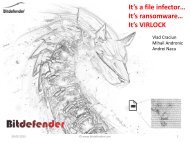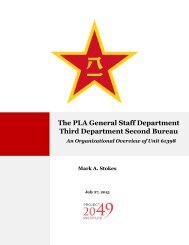content compelling comprehensive between investigations communications
pubs.php?file=/pub/10979/WhatsApp
pubs.php?file=/pub/10979/WhatsApp
Create successful ePaper yourself
Turn your PDF publications into a flip-book with our unique Google optimized e-Paper software.
Digital Investigation xxx (2015) 1e9<br />
Contents lists available at ScienceDirect<br />
Digital Investigation<br />
journal homepage: www.elsevier.com/locate/diin<br />
WhatsApp network forensics: Decrypting and understanding<br />
the WhatsApp call signaling messages<br />
F. Karpisek a , I. Baggili b, * , F. Breitinger b<br />
a Faculty of Information Technology, Brno University of Technology, Czech Republic<br />
b Cyber Forensics Research & Education Group, Tagliatela College of Engineering, ECECS, University of New Haven, 300 Boston Post Rd.,<br />
West Haven, CT, 06516, USA<br />
article<br />
info<br />
abstract<br />
Article history:<br />
Received 10 July 2015<br />
Received in revised form 17 September 2015<br />
Accepted 19 September 2015<br />
Available online xxxx<br />
Keywords:<br />
WhatsApp<br />
Reverse engineering<br />
Proprietary protocol<br />
Signaling protocols<br />
Network forensics<br />
Decryption<br />
Mobile forensics<br />
Digital forensics<br />
Cyber security<br />
Audio encoding<br />
WhatsApp is a widely adopted mobile messaging application with over 800 million users.<br />
Recently, a calling feature was added to the application and no <strong>comprehensive</strong> digital<br />
forensic analysis has been performed with regards to this feature at the time of writing this<br />
paper. In this work, we describe how we were able to decrypt the network traffic and<br />
obtain forensic artifacts that relate to this new calling feature which included the: a)<br />
WhatsApp phone numbers, b) WhatsApp server IPs, c) WhatsApp audio codec (Opus), d)<br />
WhatsApp call duration, and e) WhatsApp's call termination. We explain the methods and<br />
tools used to decrypt the traffic as well as thoroughly elaborate on our findings with<br />
respect to the WhatsApp signaling messages. Furthermore, we also provide the community<br />
with a tool that helps in the visualization of the WhatsApp protocol messages.<br />
© 2015 Elsevier Ltd. All rights reserved.<br />
Introduction<br />
WhatsApp is one of the most widely used personalmessaging<br />
mobile applications for free texting and <strong>content</strong><br />
sharing (namely audio, video, images, location and<br />
contacts), boasting over 800 million users worldwide and<br />
was bought by facebook in 2014 for $19 Billion. 1 The calling<br />
feature was added recently in version 2.11.552, which was<br />
released 2015-03-05 (Arce, 2015).<br />
From its wide adoption, it is obvious how WhastApp<br />
communication exchanges may be used during an<br />
* Corresponding author.<br />
E-mail addresses: xkarpi03@stud.fit.vutbr.cz (F. Karpisek), IBaggili@<br />
newhaven.edu (I. Baggili), FBreitinger@newhaven.edu (F. Breitinger).<br />
URL: http://www.unhcfreg.com/, http://www.FBreitinger.de/<br />
1 http://money.cnn.com/2014/02/19/technology/social/facebookwhatsapp/,<br />
last accessed 2015-07-03.<br />
investigation, making the artifacts it produces of <strong>compelling</strong><br />
forensic relevance. Therefore, we see a strong necessity<br />
for both researchers and practitioners to gain a <strong>comprehensive</strong><br />
understanding of the networking protocol used in<br />
WhatsApp, as well as the type of forensically relevant data<br />
it contains. Most importantly, due to the newly introduced<br />
calling feature, it becomes essential to understand the<br />
signaling messages used in the establishment of calls <strong>between</strong><br />
the WhatsApp clients and servers. The methods and<br />
tools used in this research could be relevant to <strong>investigations</strong><br />
where proving that a call was made at a certain<br />
date and time is necessary.<br />
Our contribution outlines the WhatsApp messaging<br />
protocol from a networking perspective and provides a<br />
solution to explore and study WhatsApp network <strong>communications</strong>.<br />
In terms of novelty, to our knowledge, this is<br />
the first paper that discusses the WhatsApp signaling<br />
messages used when establishing voice calls. The work has<br />
http://dx.doi.org/10.1016/j.diin.2015.09.002<br />
1742-2876/© 2015 Elsevier Ltd. All rights reserved.<br />
Please cite this article in press as: Karpisek F, et al., WhatsApp network forensics: Decrypting and understanding the WhatsApp<br />
call signaling messages, Digital Investigation (2015), http://dx.doi.org/10.1016/j.diin.2015.09.002
2<br />
F. Karpisek et al. / Digital Investigation xxx (2015) 1e9<br />
impact on practitioners in the field that have obtained<br />
network traffic for a potential suspect, as well as providing<br />
scientists literature for better understanding the network<br />
protocol itself.<br />
The rest of the paper is organized as follows. In Section<br />
Related work we review existing work, while Section<br />
WhatsApp protocol describes the WhatsApp protocol.<br />
Then, in Section Tool for visualizing WhatsApp protocol<br />
messages we describe the tool we created for visualizing<br />
exchanged WhatsApp messages. In Section Decryption, we<br />
describe the process of obtaining decrypted connections<br />
<strong>between</strong> the WhatsApp client and the WhatsApp server.<br />
Then in Section Findings we examine the message <strong>content</strong>s<br />
and discuss the meaning of the signaling messages during a<br />
WhatsApp call. Finally, in Section Conclusions, we offer<br />
concluding remarks and outline some future research.<br />
Related work<br />
There has been research conducted on the forensics of<br />
WhatsApp but the majority of that work focused on the<br />
data that WhatsApp stores on the mobile device when<br />
compared to our work which focuses on the network forensics<br />
of WhatsApp.<br />
Network protocol forensics<br />
At the time of writing this paper, the work on network<br />
protocol forensics of WhatsApp was sparse. The only work<br />
that provided any detail on WhatsApp's networking protocol<br />
was the Hancke (2015) report. Hancke (2015)'s work<br />
focused more on Realtime Transport Protocol (RTP) media<br />
streams (Schulzrinne et al., 2003). The report fails to uncover<br />
the call signaling messages used by WhatsApp, which<br />
is elaborated on by our work.<br />
Mobile device forensics<br />
Anglano (2014) performed an in-depth analysis of<br />
WhatsApp on Android devices. The work provided a<br />
<strong>comprehensive</strong> description of the artifacts generated by<br />
WhatsApp and discussed the decoding, interpretation and<br />
relationship <strong>between</strong> the artifacts. Anglano (2014) was able<br />
to provide an analyst with the means of reconstructing the<br />
list of contacts and chronology of the messages that have<br />
been exchanged by users.<br />
The works by Thakur (2013) and Mahajan et al. (2013) are<br />
similar to previous studies since they both focused on the<br />
forensic analysis of WhatsApp on Android. These studies<br />
uncovered the forensic acquisition of the artifacts left by<br />
WhatsApp on the device. Thakur (2013) focused on the<br />
forensic analysis of WhatsApp artifacts on an Android phone's<br />
storage and volatile memory. The results showed that one is<br />
able to obtain many artifacts such as phone numbers, messages,<br />
media files, locations, profile pictures, logs and more.<br />
Mahajan et al. (2013) analyzed WhatsApp and Viber artifacts<br />
using the Cellebrite Forensic Extraction Device (UFED) toolkit.<br />
They were able to recover contact lists, exchanged messages<br />
and media including their timestamps and call details.<br />
Walnycky et al. (2015) examined 20 different popular<br />
mobile social-messaging applications for Android including<br />
WhatsApp. In their work, they focused on unencrypted<br />
traffic that could be easily reconstructed. WhatsApp was<br />
found to be favorable at encrypting its network traffic when<br />
compared to other mobile social-messaging applications.<br />
Therefore, based on the primarily findings by Walnycky<br />
et al. (2015), our study aimed at further investigating and<br />
dissecting the WhatsApp protocol, and in specific, focusing<br />
on the signaling messages used when establishing WhatsApp<br />
calls given this new feature. However, in order to dive<br />
deeper into the signaling messages, one must understand<br />
some known attributes of the WhatsApp protocol which<br />
we discuss in Section WhatsApp protocol below.<br />
WhatsApp protocol<br />
WhatsApp uses the FunXMPP protocol for message exchange<br />
which is a binary-efficient encoded Extensible<br />
Messaging and Presence Protocol (XMPP) (WHAnonymous,<br />
2015c). The WhatsApp protocol is also briefly described by<br />
LowLevel-Studios (2012) from an implementation perspective.<br />
To fully describe the FunXMPP protocol is beyond this<br />
paper's scope. For more information on the protocol the<br />
readers may want visit a website outlining the protocol. 2<br />
Authentication procedure<br />
There are two types of authentication procedures the<br />
WhatsApp client can use when connecting to the servers. If<br />
it is the first time the client is connecting to the server, a full<br />
handshake is performed as illustrated in Fig. 1. Subsequently,<br />
for any consecutive connections, only a half<br />
handshake is executed using data provided from the initial<br />
full handshake.<br />
We note that a half handshake therefore results in using<br />
the same session keys multiple times, which can be<br />
deemed as a plausible protocol security weakness.<br />
Full handshake<br />
The authentication procedure as described by the developers<br />
of WhatsAPI consists of three messages<br />
(WHAnonymous, 2015a). This is synonymous with the well<br />
known three-way handshake and is described in detail in<br />
the following paragraphs. These messages can be observed<br />
in Fig. 1 which was created using our developed tool (for<br />
more details see Section Tool for visualizing WhatsApp<br />
protocol messages).<br />
As shown in Fig. 1, first, the client sends an <br />
message to the server. This message is not encrypted and<br />
contains the client number and authentication method the<br />
client wants to use.<br />
Then, the server replies with a message<br />
containing a 20 byte long nonce for the session key generation.<br />
Session keys are then generated using the Password-<br />
Based Key Derivation Function 2 (PBKDF2) algorithm using<br />
the password as a passphrase and the nonce as a salt. Both<br />
the server and the client know the password and nonce so<br />
the generated keys are the same on both ends. Four keys are<br />
2 https://github.com/WHAnonymous/Chat-API/wiki/FunXMPP-<br />
Protocol, last accessed 2015-07-03.<br />
Please cite this article in press as: Karpisek F, et al., WhatsApp network forensics: Decrypting and understanding the WhatsApp<br />
call signaling messages, Digital Investigation (2015), http://dx.doi.org/10.1016/j.diin.2015.09.002
F. Karpisek et al. / Digital Investigation xxx (2015) 1e9 3<br />
Fig. 1. Full handshake <strong>between</strong> WhatsApp client and server. Note: Numbers on the left side represent packet numbers (see Appendix A for the source pcap file).<br />
Also, there can be multiple messages in one packet.<br />
generated in total: two keys for confidentiality (one for each<br />
direction e from the server and to server) and two keys for<br />
the integrity check (again one for each direction).<br />
The client then creates a message that<br />
consists of a concatenated client phone number in ASCII,<br />
nonce sent by the server in binary, current Unix timestamp<br />
in ASCII and other device description data. This message is<br />
encrypted using the generated session keys and it is prepended<br />
by the hash of the message for integrity checking<br />
purposes. Decrypted <strong>content</strong>s of the response message are<br />
illustrated in Fig. 2, where we can see the aforementioned<br />
fields e their hexadecimal value and also the ASCII representation<br />
as displayed by Wireshark.<br />
If registration is successful, the server replies with a<br />
message that is encrypted. Otherwise, the server<br />
replies with a message that is not encrypted.<br />
Half handshake<br />
A half handshake consists only of an message<br />
that already contains the data of a message<br />
described above, and the server's reply, a message.<br />
The client uses the nonce from the earlier session<br />
which means that this nonce is not known by outsiders,<br />
therefore, it is not possible to decrypt such a session, as<br />
session encryption keys cannot be determined.<br />
Tool for visualizing WhatsApp protocol messages<br />
Description<br />
Our tool is a command-line program written in Python<br />
(version 2.7). It is named convertPDML.py as it converts the<br />
PDML file exported from Wireshark to an HTML report. It is<br />
available in the form of source code, see Appendix A for<br />
more details. It requires one input parameter; a path to an<br />
XML file containing the details of dissected packets. See the<br />
step 6 in Section Decryption procedure for details on how<br />
to create the XML file.<br />
The output of the tool is a report file containing all the<br />
messages exchanged <strong>between</strong> the WhatsApp client and the<br />
WhatsApp servers in HTML format as shown in Fig. 1.<br />
Hence, any standard browser can be used to view the results.<br />
Messages are ordered chronologically as they appear<br />
in the input XML file.<br />
Please cite this article in press as: Karpisek F, et al., WhatsApp network forensics: Decrypting and understanding the WhatsApp<br />
call signaling messages, Digital Investigation (2015), http://dx.doi.org/10.1016/j.diin.2015.09.002
4<br />
F. Karpisek et al. / Digital Investigation xxx (2015) 1e9<br />
Fig. 2. Content of message with marked regions.<br />
Usage<br />
As mentioned above, the tool requires am XML file as an<br />
input parameter. Example: convertPDML.py INPUT.xml.<br />
Network traffic collection<br />
This section explains how we collected the WhatsApp<br />
network traffic. More details are presented in Sections<br />
Experimental setup and High level methodology.<br />
Experimental setup<br />
We used the setup exemplified in Fig. 3 for capturing<br />
network traffic <strong>between</strong> the WhatsApp messenger running<br />
on an Android phone and the WhatsApp servers. The<br />
hardware and software used in the experimental setup are<br />
listed below:<br />
Equipment used in experimental setup:<br />
<br />
<br />
Phone: Lenovo P780, Android 4.2.1, running<br />
e Whatsapp v2.12.84 which was downloaded from<br />
the Google play store.<br />
e Password Extractor v1.0 3 .<br />
Laptop: Lenovo ThinkPad T420s with Windows 7 64-bit<br />
with the following installed software:<br />
e Wireshark v1.12.5, 32-bit, with the WhatsApp<br />
dissector. 4<br />
e Pidgin v2.12.11, 5 32-bit, with the WhatsApp plugin. 6<br />
application to gain access to the WhatsApp password. We<br />
note that the phone had to be rooted to use this application.<br />
We would also like to mention that there could have been<br />
multiple ways to gain access to the password on the device<br />
such as using commercially available tools to acquire a<br />
forensic image of the phone, and in some cases gaining<br />
access to the password can be achieved without rooting the<br />
phone if the acquisition method allows the investigator to<br />
acquire the image without rooting the device.<br />
We then utilized Pidgin messenger with the WhatsApp<br />
plugin and obtained the WhatsApp password for connecting<br />
to the WhatsApp servers in order to desynchronize the<br />
WhatsApp client installed on the Android phone. This was<br />
performed in order for us to capture the full handshake (see<br />
Section Full handshake for more details).<br />
The next step included setting up a wifi access point (see<br />
Fig. 3) on the laptop and sharing the Internet connection<br />
from the Ethernet port to the wifi adapter. The laptop now<br />
acted as a wifi router. We then started capturing all the<br />
traffic on the access point's network. In the next step, we<br />
connected the phone to the created wifi network and made<br />
a WhatsApp call to a user with phone number 1-203-xxxxxxx.<br />
Finally, we finished capturing the traffic and saved<br />
the created pcap file.<br />
Following the aforementioned methodology allowed us<br />
to collect network traffic enabling us to perform exploratory<br />
analysis. In the following Section Decryption, we<br />
outline the resultant steps that we were able to reproduce<br />
for decrypting the WhatsApp messaging traffic.<br />
High level methodology<br />
First, we disconnected the Android phone from any<br />
Internet connection and used the Password Extractor<br />
3 https://www.mgp25.com/downloads/pw.apk, last accessed 2015-07-<br />
06.<br />
4 https://davidgf.net/page/37/whatsapp-dissector-for-wireshark, last<br />
accessed 2015-07-06.<br />
5 https://pidgin.im/, last accessed 2015-07-06.<br />
6 https://davidgf.net/whatsapp/, last accessed 2015-07-06.<br />
Decryption<br />
According to LowLevel-Studios (2012) and<br />
WHAnonymous (2015a), encryption and decryption in<br />
WhatsApp is performed with a symmetric RC4 stream cipher<br />
using keys generated during authentication which is<br />
described in the Section Authentication procedure.<br />
Therefore, in order to decrypt the communication <strong>between</strong><br />
the WhatsApp servers and the WhatsApp client,<br />
session keys for each direction (as WhatsApp uses one key<br />
for communication from device to the server and a<br />
different one for communication from the server to the<br />
Please cite this article in press as: Karpisek F, et al., WhatsApp network forensics: Decrypting and understanding the WhatsApp<br />
call signaling messages, Digital Investigation (2015), http://dx.doi.org/10.1016/j.diin.2015.09.002
F. Karpisek et al. / Digital Investigation xxx (2015) 1e9 5<br />
Fig. 3. Experimental setup.<br />
device) are required. The process of obtaining these keys is<br />
provided in Section Full handshake.<br />
Prerequisites<br />
Our work showed that there are two mandatory requirements<br />
for the successful decryption of WhatsApp<br />
messaging connections:<br />
<br />
<br />
The password associated with the WhatsApp account.<br />
The record of the full handshake <strong>between</strong> the WhatsApp<br />
client and the server.<br />
Tools used<br />
We outline the list of software tools that were used in<br />
the decryption process:<br />
<br />
<br />
<br />
<br />
To obtain the password, there are multiple options<br />
based on the mobile device being used (WHAnonymous,<br />
2015b). As we were using an already rooted Android<br />
phone, the easiest way was to extract the password<br />
using the Password Extractor application.<br />
To force WhatsApp to establish a full handshake the<br />
next time the mobile device connected to the server, it<br />
was necessary to break the synchronization <strong>between</strong><br />
the WhatsApp client and the server. The simplest way<br />
for doing that was to connect using a different client. For<br />
that purpose, we used the IM client Pidgin alongside the<br />
WhatsApp plugin.<br />
To decrypt the WhatsApp connection <strong>between</strong> the client<br />
and server, we used Wireshark and a WhatsApp-specific<br />
dissector.<br />
To visualize the WhatsApp protocol message exchange<br />
we created a command-line tool described in Section<br />
Tool for visualizing WhatsApp protocol messages.<br />
Decryption procedure<br />
In this section, we elaborate using a step-by-step procedure<br />
describing how to successfully decrypt and visualize<br />
the exchange of WhatsApp protocol's messages <strong>between</strong><br />
the WhatsApp client and the servers.<br />
1. As the Android phone we were using, was rooted,<br />
obtaining the password was as easy as installing and<br />
running an application mentioned in the Section Tools<br />
used. In our case, the username (phone number) was<br />
420xxxxxxxxx with the following extracted password<br />
627XlMqch8i5Ncy2tRSbZLXs2m0¼.<br />
2. After obtaining credentials for the WhatsApp account<br />
(phone number and password), we disconnected the<br />
mobile device running WhatsApp from the wifi network<br />
and used the IM client Pidgin with the WhatsApp plugin<br />
and used the obtained credentials to log into our<br />
WhatsApp account. This broke the synchronization <strong>between</strong><br />
the WhatsApp client on the mobile device and the<br />
WhatsApp server forcing the client to authenticate using<br />
a full handshake.<br />
3. We then connected the mobile device running the<br />
WhatsApp client back to the wifi access point capturing<br />
all the communication from and to the mobile device as<br />
explained in Section Experimental setup. After the<br />
WhatsApp client logged into the WhatsApp account, we<br />
placed a WhatsApp call to another device. All recorded<br />
communication was saved to a pcap file. Access to the<br />
pcap file is presented in the Appendix A.<br />
4. After we captured all the communication <strong>between</strong> the<br />
WhatsApp client and the WhatsApp server, we provided<br />
the WhatsApp dissector in Wireshark with the credentials<br />
we obtained in the prior steps. To do that we used<br />
Wireshark's menu Edit e> Preferences and in the Protocols<br />
section we set up the WhatsApp dissector with<br />
the same options exemplified in Fig. 4.<br />
After setting up the WhatsApp dissector correctly, we were<br />
able to observe the <strong>content</strong> of encrypted messages and the<br />
<strong>content</strong> of the message should start with the<br />
number used in message as shown in Fig. 2.<br />
5. When the communication was decrypted we exported it<br />
to XML format using Wireshark's function File e> Export<br />
Packet Dissections e> as XML e “PDML” (packet details)<br />
file.... We provide access to this XML file in the Appendix<br />
A. Part of this XML file e namely is illustrated in<br />
Listing 1 where we can see the same values as in <br />
Please cite this article in press as: Karpisek F, et al., WhatsApp network forensics: Decrypting and understanding the WhatsApp<br />
call signaling messages, Digital Investigation (2015), http://dx.doi.org/10.1016/j.diin.2015.09.002
6<br />
F. Karpisek et al. / Digital Investigation xxx (2015) 1e9<br />
message from Fig. 1 e attribute user with value<br />
420xxxxxxxxx (lines 33e38) and attribute mechanism<br />
with value WAUTH-2 (lines 39e44).<br />
6. The final step involved using our tool to generate a<br />
report of the WhatsApp message exchange <strong>between</strong> the<br />
WhatsApp client and WhatsApp servers. For that we<br />
used the XML file generated in the previous step. For<br />
more details refer to the Section Tool for visualizing<br />
WhatsApp protocol messages.<br />
Findings<br />
In the following subsections, we describe our findings<br />
on the signaling messages used for call establishment in<br />
WhatsApp. For a visual representation of our findings<br />
readers may want to refer to Fig. 5.<br />
Protocol analysis of call signaling messages<br />
Fig. 4. WhatsApp Wireshark dissector settings.<br />
In this section we elaborate on messages that we hypothesize<br />
are part of the establishment of a WhatsApp call<br />
as we observed it in the decrypted captured communication<br />
traffic. We used the captured pcap file and the HTML<br />
report generated from the same pcap file (refer to the<br />
Section Decryption procedure for more details). Both of<br />
these files can be downloaded from Appendix A. In the rest<br />
of this section, we refer to the packet numbers displayed on<br />
the leftmost side in the flow diagram of signaling message<br />
exchange in Fig. 5.<br />
First (in packets [8]e[32]), the WhatsApp client connects<br />
and authenticates with the first WhatsApp server<br />
174.37.231.87 but there is no activity regarding a call.<br />
Starting with packet [33], the WhatsApp client connects<br />
and authenticates to a second WhatsApp server<br />
174.36.210.45 and starts placing a call.<br />
Right after connecting to the second server, in packet<br />
[41], the client asks for the presence of the called party<br />
Fig. 5. Signaling messages of WhatsApp call (numbers refer to packet<br />
numbers).<br />
Please cite this article in press as: Karpisek F, et al., WhatsApp network forensics: Decrypting and understanding the WhatsApp<br />
call signaling messages, Digital Investigation (2015), http://dx.doi.org/10.1016/j.diin.2015.09.002
F. Karpisek et al. / Digital Investigation xxx (2015) 1e9 7<br />
(phone number 1-203-xxx-xxxx) and starts the call<br />
establishment process by sending message to<br />
the called party. This happens in packet [42]. There we<br />
can observe the property call-id¼“1431719979-2” for the<br />
first time. This property remains constant throughout<br />
the rest of the signaling messages during the whole<br />
signaling process and it identifies the call as it is unique<br />
for each call and therefore changes every time a call is<br />
initiated.<br />
In this first message we can also observe that the caller is<br />
offering to use the Opus codec (Valin et al., 2012) (in property<br />
) for voice data in two sampling rates, 8 kHz<br />
and 16 kHz. We also observe the properties (value of<br />
16 bytes ¼ 128 bits) and (192 bytes ¼ 1536 bits)<br />
values which we were not able to decode. We postulate that<br />
they might be some kind of initialization vectors for<br />
encryption of media streams and/or description of these<br />
streams. The last property is contains a 6 byte value<br />
that we decoded as the endpoint (IP address and port)<br />
where the client announces the endpoint address for the<br />
media stream. Its value is 192.168.137.208:46416.<br />
The server replies with in packet [43] which<br />
contains property (value of 204 bytes ¼ 1632 bits)<br />
which we were also unable to decode, multiple properties<br />
that announce endpoint addresses of relay servers (8<br />
servers in total), and properties , (gain<br />
control) and (noise suppression) that we hypothesize<br />
further specify media encoding.<br />
Packets [44] and [45] carry messages and of<br />
the receipt. To the best of our knowledge, these messages<br />
do not contain any data of interest.<br />
Packet [46] going from the server to the client carries the<br />
message and has the property that<br />
asserts that the used codec for media streams will be the<br />
Opus codec at the sampling rate of 16 kHz. It also contains<br />
the property that has the same length as the same<br />
property in packet [42] (192 bytes ¼ 1536 bits) but<br />
carries different value.<br />
Packet [47] carries the message which contains<br />
the client's endpoint address but from an external point<br />
of view e a public endpoint address. This address is found out<br />
by the client using Traversal Using Relays around NAT (TURN)<br />
mechanism (Mahy et al., 2010) e client asks the TURN server<br />
what is its (client's) IP address from the outside point of view.<br />
Its value is 64.251.61.74:62334 which differs from the value<br />
in packet [42] e 192.168.137.208:46416. Packet [48] carries<br />
the message to the previous message.<br />
We can observe a relay server election in packets [49]e<br />
[65]. The client finds out latency <strong>between</strong> itself and the<br />
relay servers obtained from message from packet<br />
[43] and one of the servers is elected.<br />
The last message of the call establishment process is<br />
message in packet [70]. It contains the property<br />
that confirms that the used codec is Opus, sampling<br />
rate 16 kHz, properties and (with the<br />
same value as in packet [47]) and two endpoint addresses:<br />
private e 192.168.1.22:55607 and public e<br />
64.251.61.74:55607. These endpoint addresses are used<br />
when trying to establish a direct peer-to-peer (P2P)<br />
connection. Packet [71] contains message confirming<br />
the previous message.<br />
After that, both-way media stream is established from<br />
192.168.137.208:46416 to 31.13.74.48:3478 using RTP. These<br />
addresses were announced in a message in packet [42] and<br />
during the relay server election.<br />
After about 30 s of the ongoing call, the client connects<br />
to another WhatsApp server (108.168.180.110) and<br />
signaling messages start flowing through this server. The<br />
client then announces new endpoint addresses in packets<br />
[2688] and [2711] and after a new relay election process, a<br />
new media stream is created replacing the previous one<br />
using a new endpoint address.<br />
Finally, the client connects to another WhatsApp server<br />
(174.37.231.88) and sends two identical messages <br />
in packets [7921] and [7925] and the call is<br />
terminated.<br />
Media streams<br />
Hancke (2015) mentioned in his report that WhatsApp<br />
uses a codec at 16 kHz sampling rate with bandwidth of<br />
about 20 kbit/s. Unlike us, Philipp Hancke did not have<br />
access to the decrypted signaling messages and thus we can<br />
now declare that WhatsApp is using the Opus codec for<br />
voice media streams at either 8 kHz or 16 kHz sampling<br />
rate which is decided at call setup.<br />
We attempted to decode the media using the opensource<br />
implementation of the Opus codec 7 but the decoded<br />
result was not voice audio. From that and from the<br />
fact that we can observe properties (SRTP stands<br />
for Secure Realtime Transport Protocol (Baugher et al.,<br />
2004)) we infer that these media streams are being<br />
encrypted.<br />
Analysis summary<br />
Through the analysis of signaling messages exchanged<br />
during a WhatsApp call we were able to:<br />
Closely examine the authentication process of WhatsApp<br />
clients.<br />
Discover what codec WhatsApp is using for voice media<br />
streams e Opus at 8 or 16 kHz sampling rates.<br />
Understand how relay servers are announced and the<br />
relay election mechanism.<br />
Understand how clients announce their endpoint addresses<br />
for media streams.<br />
Gaining insight into these signaling messages is essential<br />
for the understanding of the WhatsApp protocol<br />
especially in the area of WhatsApp call analysis from a<br />
forensic networking perspective.<br />
Forensically relevant artifacts<br />
As shown in Table 1, forensically relevant artifacts may<br />
be extracted from the network traffic using the outlined<br />
7 http://www.opus-codec.org/, last accessed 2015-07-06.<br />
Please cite this article in press as: Karpisek F, et al., WhatsApp network forensics: Decrypting and understanding the WhatsApp<br />
call signaling messages, Digital Investigation (2015), http://dx.doi.org/10.1016/j.diin.2015.09.002
8<br />
F. Karpisek et al. / Digital Investigation xxx (2015) 1e9<br />
Table 1<br />
Forensically relevant data, their location and sample data.<br />
methodology. Most notably (see Fig. 1), we were able to<br />
acquire the following artifacts from the network traffic:<br />
WhatsApp phone numbers.<br />
WhatsApp phone call establishment metadata and<br />
datetime stamps.<br />
WhatsApp phone call termination metadata and datetime<br />
stamps.<br />
WhatsApp phone call duration metadata and datetime<br />
stamps.<br />
WhatsApp's phone call voice codec (Opus).<br />
WhatsApp's relay server IP addresses used during the<br />
calls.<br />
Conclusions<br />
In this work, we decrypted the WhatsApp client<br />
connection to the WhatsApp servers and visualized messages<br />
exchanged through such a connection using a<br />
command-line tool we created. This tool may be useful for<br />
deeper analysis of the WhatsApp protocol.<br />
We also uncovered the hypothesized signaling messages<br />
of the WhatsApp call which revealed what codec is<br />
being actually used for media transfer (Opus), as well as<br />
forensically relevant metadata about the call establishment,<br />
termination, duration and phone numbers associated<br />
with the call.<br />
Future work<br />
In this work we were unable to decode media RTP<br />
streams as they seem to be encrypted. However, we hypothesize<br />
that encryption keys are most likely being<br />
transferred inside the signaling messages during the set up<br />
of a WhatsApp call and therefore we postulate that it<br />
should be possible, in theory, to decrypt these media<br />
streams as well. The main challenge for this task is to find<br />
out the encryption keys and encryption algorithm used.<br />
We would also like to note that a limitation of our<br />
work is that it was tested on an Android device. Although<br />
we hypothesize that the protocol used in the communication<br />
will be constant across platforms, recreating the<br />
experiments with different devices and operating systems<br />
running WhatsApp is needed to validate that claim.<br />
Also, we would like to note that as more features are<br />
added to WhatsApp, more experiments need to be conducted<br />
to ensure that the design of the protocol does not<br />
change.<br />
We would also like to encourage other researchers to<br />
apply the techniques explained in our work to analyze the<br />
network traffic of other popular messaging applications so<br />
that the forensic community can gain a better understanding<br />
of the forensically relevant artifacts that may be<br />
extracted from the network traffic, and not only the data<br />
stored on the devices.<br />
Please cite this article in press as: Karpisek F, et al., WhatsApp network forensics: Decrypting and understanding the WhatsApp<br />
call signaling messages, Digital Investigation (2015), http://dx.doi.org/10.1016/j.diin.2015.09.002
F. Karpisek et al. / Digital Investigation xxx (2015) 1e9 9<br />
Appendix A. Reference files<br />
These are files that were used throughout this paper.<br />
These files can be provided to researchers by visiting our<br />
website http://www.unhcfreg.com under Tools & Data.<br />
<br />
<br />
<br />
<br />
whatsapp_register_and_call.pcap e pcap file containing<br />
user with phone number 420xxxxxxxxx connecting to<br />
multiple WhatsApp servers and placing a call to the user<br />
with phone number 1-203-xxx-xxxx.<br />
whatsapp_register_and_call.xml e <strong>content</strong> of previous<br />
pcap file exported from Wireshark in XML format.<br />
whatsapp_register_and_call.html e HTML file that was<br />
generated from previous XML file using our tool.<br />
convertPDML.py e command-line tool for converting<br />
XML files exported from Wireshark to a visual HTML<br />
report containing flow of WhatsApp messages exchanged<br />
<strong>between</strong> WhatsApp Messenger and the WhatsApp<br />
servers.<br />
References<br />
Anglano C. Forensic analysis of whatsapp messenger on android smartphones.<br />
Digit Investig 2014;11:201e13. URL, http://www.sciencedirect.<br />
com/science/article/pii/S1742287614000437 [last accessed 06.07.15].<br />
Arce N. Whatsapp calling for android and IOS: How to get it and what to<br />
know. 2015. URL, http://www.techtimes.com/articles/38291/20150309/<br />
whatsapp-calling-for-android-and-ios-how-to-get-it-and-what-toknow.htm<br />
[last accessed 27.05.15].<br />
Baugher M, McGrew D, Naslund M, Carrara E, Norrman K. The secure realtime<br />
transport protocol (SRTP). 2004. URL, https://www.ietf.org/rfc/<br />
rfc3711.txt [last accessed 06.07.15].<br />
Hancke P. Whatsapp exposed: Investigative report. 2015. URL, https://<br />
webrtchacks.com/wp-<strong>content</strong>/uploads/2015/04/WhatsappReport.pdf<br />
[last accessed 03.06.15].<br />
LowLevel-Studios. Whatsapp protocol 1.2: a brief explanation. 2012. URL,<br />
http://lowlevel-studios.com/whatsapp-protocol-1-2-a-briefexplanation/<br />
[last accessed 03.06.15].<br />
Mahajan A, Dahiya M, Sanghvi H. Forensic analysis of instant messenger<br />
applications on android devices. 2013. arXiv preprint arXiv:1304.4915,.<br />
URL, http://arxiv.org/abs/1304.4915 [last accessed 06.07.15].<br />
Mahy R, Matthews P, Rosenberg J. Traversal using relays around NAT<br />
(TURN). 2010. URL, https://tools.ietf.org/html/rfc5766 [last accessed<br />
06.07.15].<br />
Schulzrinne H, Casner S, Frederick R, Jacobson V. RTP: a transport protocol<br />
for real-time applications. 2003. URL, https://www.ietf.org/rfc/<br />
rfc3550.txt [last accessed 06.07.15].<br />
Thakur NS. Forensic analysis of WhatsApp on android smartphones<br />
(Master's thesis). University of New Orleans; 2013. URL, http://<br />
scholarworks.uno.edu/td/1706/ [last accessed 06.07.15].<br />
Valin J, Vos K, Terriberry T. Definition of the opus audio codec. 2012. URL,<br />
http://tools.ietf.org/html/rfc6716 [last accessed 06.07.15].<br />
Walnycky D, Baggili I, Marrington A, Moore J, Breitinger F. Network and<br />
device forensic analysis of android social-messaging applications.<br />
Digit Investig 2015;14:S77e84.<br />
WHAnonymous. Authentication overview (WAUTH 2). 2015. URL, https://<br />
github.com/WHAnonymous/Chat-API/wiki/Authentication-<br />
Overview-(WAUTH-2. https://github.com/WHAnonymous/Chat-API/<br />
wiki/Authentication-Overview-(WAUTH-2) [last accessed 03.06.15].<br />
WHAnonymous. Extracting password from device. 2015. URL, https://<br />
github.com/WHAnonymous/Chat-API/wiki/Extracting-passwordfrom-device<br />
[last accessed 12.06.15].<br />
WHAnonymous. Funxmpp-protocol. 2015. URL, https://github.com/<br />
WHAnonymous/Chat-API/wiki/FunXMPP-Protocol [last accessed<br />
03.06.15].<br />
Please cite this article in press as: Karpisek F, et al., WhatsApp network forensics: Decrypting and understanding the WhatsApp<br />
call signaling messages, Digital Investigation (2015), http://dx.doi.org/10.1016/j.diin.2015.09.002










